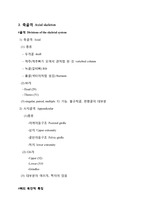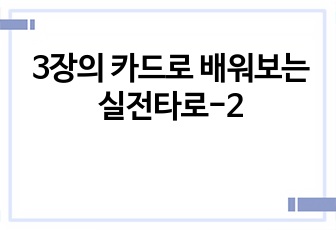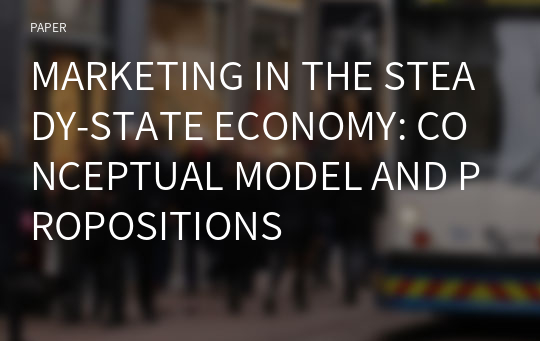MARKETING IN THE STEADY-STATE ECONOMY: CONCEPTUAL MODEL AND PROPOSITIONS
* 본 문서는 배포용으로 복사 및 편집이 불가합니다.
서지정보
ㆍ발행기관 : 글로벌지식마케팅경영학회(GFMC)
ㆍ수록지정보 : Global Marketing Conference
ㆍ저자명 : Akinori Iwamoto, Satoko Suzuki, Tomoko Kawakami
ㆍ저자명 : Akinori Iwamoto, Satoko Suzuki, Tomoko Kawakami
영어 초록
IntroductionKotler (2015) warned that, if we only pursue economic growth and revenue/profit expansion, we will end up with overconsumption and wastes, bringing serious damage to our planet. He advocated the transition from the growth-oriented economy to the steady-state economy. Steady state economy is defined as an economy that maintains desired sufficient level of throughput with the lowest feasible flows of matter and energy from production to consumption (Kotler, 2015). As Kotler mentioned, this idea is somewhat utopian as most companies are still living in the growth-oriented economy. The purpose of this research is to extend Kotler’s idea by conceptualizing a more concrete model to visualize the marketing in the steady state economy. The model consists of five major elements; customers, stakeholders, employees, suppliers and community. The authors also present twelve propositions that explain promoting factors for the marketing in the steady state economy based on the multiple case studies conducted in Japan.
Literature review
The steady-state economy itself is actually not a new idea in economics. For example, typical classical economists (e.g., Adam Smith and John Stewart Mill) advocated the transition to the steady-state economy after saturation of economic growth. Neo-classical economists have also postulated the concept of steady state economy with regard to the law of diminishing returns (Tellis, 2008). Many previous studies have continuously put efforts on developing theories and practices to meet with economic, social and environmental needs simultaneously, since Kotler and Zaltman (1971) proposed the concept of social marketing. Although social marketing is closely related to marketing in the steady-state economy, its ethical egotism remains a problem (Crane and Desmond, 2002). Lerman and Shfrin (2015) and Gopaldas (2015) claim positive marketing which creates value for the firm, its customers, and society at large. In short, these concepts suggest the possibility that individual, self-seeking, and short-run behaviors can be consistent with aggregate, altruistic, and long-run behaviors. Besides above exceptions, however, most marketing researchers have evaded the question: What is marketing in the steady-state economy? The purpose of our study is to develop a conceptual framework to analyze “steady-oriented” companies and their marketing strategies based on the case studies in Japan.
Research methodology
In order to answer the above question, we adopt qualitative heuristic approaches (Kleining, 1994), because our question has not been addressed enough in previous studies mentioned above. First, we collected primary and secondary data from various information sources including company websites, press releases, online business journals, academic case studies, public seminars, presentations at academic meetings and so on (Yin, 2014). As stated by Eisenhardt (1989), we used a theoretical sampling to identify the informants for our multiple case studies. We intentionally chose companies from different industries, locations, length of history, manufacturing technology, etc. Based on the review and data collection, we developed a basic framework and series of theoretical propositions (Yin, 2014). For our study, we selected Japanese companies respecting “sanpo-yoshi” [good for three parties] philosophy. It is a belief that business should be good for sellers, buyers, and society. In fact, positive marketing is similar to this concept of “sanpo-yoshi” which is based on the family precepts of “Ohmi region merchants” in the Edo period (1600-1857) (Ogura, 1991; Usami 2015). Our selected “sanpo-yoshi” oriented companies aim for a harmonious relationship with all the concerning stakeholders and community (see Appendix for the list of selected companies). Figure 1 identifies five key parties covered in the “sanpo-yoshi” management and shows bilateral relations between the company and the five parties. First, “sanpo-yoshi” oriented companies try to build good long-term relationships not only with their customers by selling high-quality products at fair prices, but also with suppliers by buying a stable volume of products at fair prices. In addition, some companies provide their loyal customers with special experience concerning their own brands and their suppliers with technical assistant. In return, customers feel strong loyalty to the brand and suppliers offer a stable supply of high- quality raw materials at fair prices. Moreover, “sanpo-yoshi” companies take an active interest in their employees and the community where they operate because their confidence contributes to sustainable development of the companies. Shareholders for short-term returns, however, are unlikely to give heavy weight to social activities by their investee companies. Therefore, companies whose stocks are unlisted or occupied by long-term shareholders are more favorably inclined toward “sanpo-yoshi” management.
Research propositions
Based on the case studies of “sanpo-yoshi” companies in Japan, we argue that the enforcement of marketing in the steady-state economy can be tied to three factors: (1) management factors, (2) competitive factors, and (3) financial factors. Within these factors, twelve research propositions are developed for testing in the future research (Eisenhardt and Gaebner, 2007). These factors and propositions are summarized in Figure 2. Management factors are divided into two subcomponents: decision-making and employment factors. First, decision-making factors basically mean that the independence of management from the investors seeking short-term profits enables the management to enforce steady-oriented marketing. The most feasible method is corporate governance by founders or his/her family, although it is not a requirement. For instance, Kagome Co., Ltd. ended the family business operation in 1996, and around 180,000 individual “fan shareholders” accounting for 55.4% (Nikkei, 2017) are supporting the management with a long-term perspective. Second, employment factors indicate that the companies are likely to enforce steady-oriented marketing when they maintain high labor productivity and excellent human resources. In particular, it is more important for companies having many female employees with accumulated experience and know-hows to prevent those employees from quitting the job because of pregnancy or child rearing. Competitive factors are associated with the conditions of the steady state economy surrounding the companies. If the companies have maintained high market share in a mature market for many years, they can afford to enforce “sanpo-yoshi” oriented marketing for sustainability. In terms of financial factors, equity ratio shows the soundness of management, which has positive effects on the enforcement of marketing in the steady state economy. Moreover, ROE measures a company’s profitability by revealing how much profit a company generates with the money which its shareholders have invested. Finally, payout ratio provides valuable insight into a company’s dividend policy. Higher payout ratio indicates that the company is sharing more of its earnings with the shareholders.
Implications
The findings of this research contribute to the academics by providing a new framework for the marketing in the steady state economy. Further research can empirically test the proposed model in various countries to investigate if this framework is culturally specific to Japan or not. This research also provides practical implications for managers. For sustainable business and better society, companies should keep their eyes on the five elements presented in our research. Thus we can take the very first step for the marketing in the steady state economy.
참고 자료
없음"Global Marketing Conference"의 다른 논문
 THE ROLES OF GREEN PACKAGING IN UGLY FOOD PURCHASE INTE..22페이지
THE ROLES OF GREEN PACKAGING IN UGLY FOOD PURCHASE INTE..22페이지 THE IMPACT OF INDUCED AWE ON ETHICAL TOURIST BEHAVIORS5페이지
THE IMPACT OF INDUCED AWE ON ETHICAL TOURIST BEHAVIORS5페이지 A BIBLIOMETRIC ANALYSIS OF SPIRITUAL TOURISM RESEARCH15페이지
A BIBLIOMETRIC ANALYSIS OF SPIRITUAL TOURISM RESEARCH15페이지 SOCIAL NETWORK ANALYSIS AND RESPONSE TIME TESTING: CONS..11페이지
SOCIAL NETWORK ANALYSIS AND RESPONSE TIME TESTING: CONS..11페이지 THE EFFECTS OF PARA-SOCIAL INTERACTION ON ONLINE CELEBR..3페이지
THE EFFECTS OF PARA-SOCIAL INTERACTION ON ONLINE CELEBR..3페이지 THE INFLUENCE OF OPINION LEADERS ON DAILY DEALS USER’S ..3페이지
THE INFLUENCE OF OPINION LEADERS ON DAILY DEALS USER’S ..3페이지 HOW IMMERSIVE RETAILING AFFECTS CONSUMERS’ URGE TO BUY:..6페이지
HOW IMMERSIVE RETAILING AFFECTS CONSUMERS’ URGE TO BUY:..6페이지 KEY TO SUPERSTARDOM IN A GLOBALISED MARKET: THE ROLE OF..6페이지
KEY TO SUPERSTARDOM IN A GLOBALISED MARKET: THE ROLE OF..6페이지 A POST-PANDEMIC LOOK AT TOURISTS’ PERCEIVED COOLNESS OF..4페이지
A POST-PANDEMIC LOOK AT TOURISTS’ PERCEIVED COOLNESS OF..4페이지 EXTRACTING OFFLINE RETAIL SHOPPING PATTERNS: OLLABORATI..5페이지
EXTRACTING OFFLINE RETAIL SHOPPING PATTERNS: OLLABORATI..5페이지


























